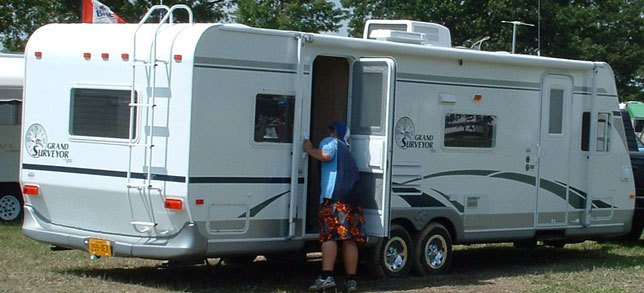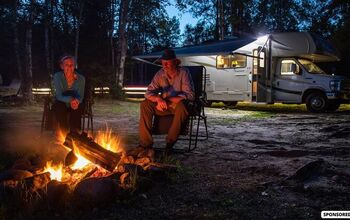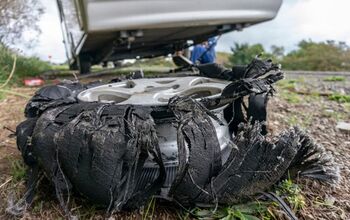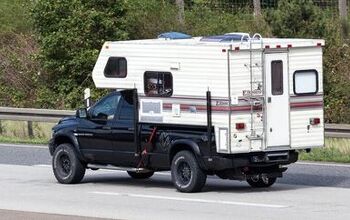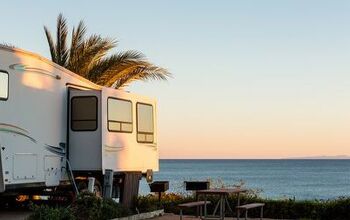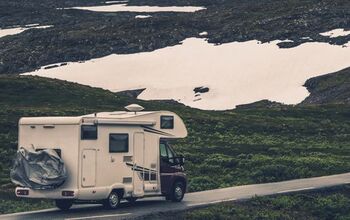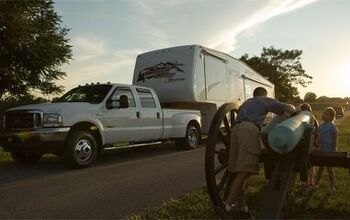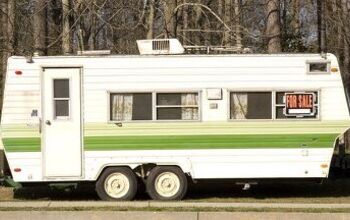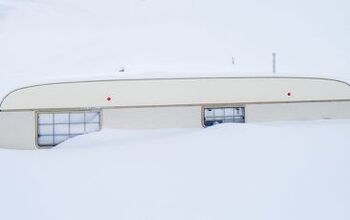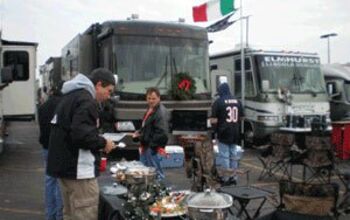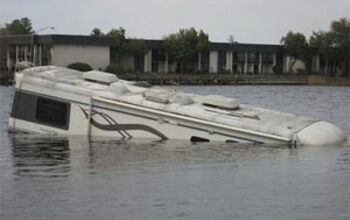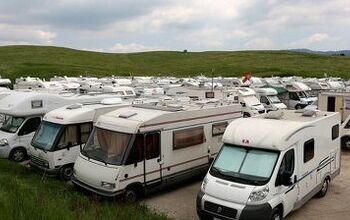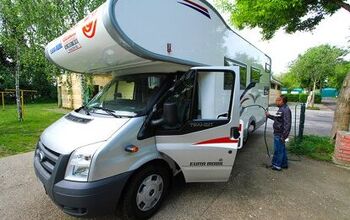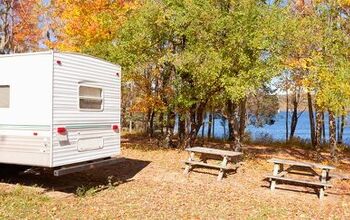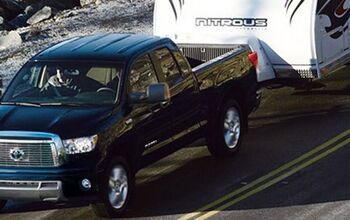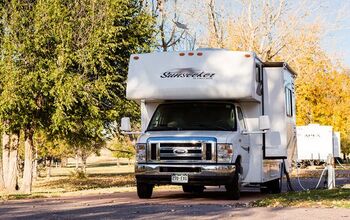2003 Forest River Grand Surveyor GS-272 Review
Watkins Glen, a small town in upstate New York, is also the name sake of a road-course race track that makes this Finger Lakes region of the Empire state famous for something more than just summer cottages. It’s one of only two road courses that the NASCAR circuit races on each year. It’s a favorite of race fans, of which perhaps as many as a 50,000 are RV campers too. This was the venue that I brought the Forest River Grand Surveyor to recently, where my sons and I spent three eventful days (and noisy nights) in.
This 30-foot travel trailer has a very trim dry weight of 4,100 lb. You can load it with another 1,500 lb for a GVWR of 5,600 lb. Barely enough to tax the suspension of the 2003 Dodge Ram 3500 diesel I used for towing. Still, this unit houses a spacious bedroom, a slideout dinette, L-shaped kitchen/breakfast counter, fold-down sofa and a full bath. Two doors offer direct bedroom access as well as salon entry. For four men (my wife bailed on this adventure) there was enough living space, and ample storage to keep our gear out from under foot for the duration.
The diesel Ram (new Cummins turbo diesel) was equipped with a six-speed manual transmission that pushed the power so well that at just over 2000 rpm in sixth I could cruise at a steady 70 mph, and even accelerate uphill, and the ride and towing was smooth. This trailer has twin axles, easy lube hubs, radial tires and electric brakes on all wheels.
Part of the smooth ride we were getting must have had to do with the aerodynamics that Forest River makes a point of stressing in its Grand Surveyor literature. Forest River claims that this trailer line uses race car technology to make towing easier and more stable. Certainly the trailer runs a low profile, but more importantly its underside is completely enclosed. There are no exposed tanks, pipes or outriggers, thus allowing smooth flowing air currents to pass below the unit. This enclosed underbelly has also been designed to be warmed by radiant heat passing from the under-floor heat ducting. Along with insulation this makes the Grand Surveyor cold weather ready as all the tanks and water lines are then protected from freezing. To access any of components removable aluminum panels are removed for service. Using just an ordinary hitch receiver for this test, I found that the low center of gravity and aerodynamically stable configuration of my test trailer made for a completely uneventful drive; and that’s the best kind.
Arriving at our campsite, I noted that we were going to be dry camping. I hadn’t exactly planned on this, but it became part of the experience and a testament to our ingenuity. With 30 gallons of fresh water on board, rationing was enforced and it turned out that three days was exactly how long we could stretch that water. A 4L jug of drinking water fit nicely in the Dometic refrigerator as did a variety of other beverages. In addition enough food, fresh and frozen, was accommodated to last our entire weekend. This two-way fridge runs on either shore power or propane. In our case the twin 30-lb propane tanks were more than enough to run the fridge and the six-gallon hot water heater for the duration. The standard thirty thousand BTU Atwood furnace would of course consume the most propane, but I’d estimate that even at freezing temperatures the two propane tanks should be enough for four to five days.
The single house battery ran the 12V demand water pump, AM/FM/CD player, plenty of interior (and one exterior amber) lights and the bathroom exhaust fan. It also powered the Liftco slide-out mechanism. We had opportunity to extend and retract this unit several times, it worked without a hitch. The house battery recharged itself when it was plugged into shore power and/or when attached to the tow vehicle.
We were fortunate to have some nice neighbors who let us plug into their generator for a few hours at a time – letting the boys watch a movie on our TV/VCR combo and recharging the house battery – otherwise about 24 hours of steady use is all you can expect of this battery.
The construction of the trailer is framed aluminum, with 3 inches of block foam insulation in the roof (R11) and 1.5 inches of foam insulation in the walls and floor (R7). The roof is rubber and the exterior walls fiberglass; a product called Lamilux Super 1000, smooth and very clean. Using the roof for race viewing proved popular with my boys, thankfully the roof supported them without incident, as did the optional aluminum roof ladder. It was here that I made two notes to pass on to Forest River quality control. One: several screws had been over-torqued and were ripped out of the wood on the ladder fittings, they were still in place but held nothing. Two: an overzealous caulker had pushed so much silicon in around the TV antenna that it wouldn’t turn – till we dug it out. These are things that a dealer can quickly fix, but they should be caught at the factory.
The A&E awning is an option, but one that shouldn’t be passed up. Our test unit was fitted with one that covered both doors and kept our lawn chairs and sundry items dry despite almost 2.5 inches of rain that weekend. There was mud everywhere, except inside the trailer thanks to that awning. Storage throughout the Grand Surveyor is very good – there is a place for everything and plenty of it. I particularly liked the pull-out plastic storage bin that you access from the outside, which runs right through the trailer at the rear. I never had a chance to run the air conditioner, so I can’t say if it’s loud or cools well – but with the windows open we ran the bathroom vent fan on high – exhaust – and drew air through the trailer to keep us cool and help us sleep, though the jubilant NASCAR fans kept us up anyway. Well, that’s part of racing and RVing.
